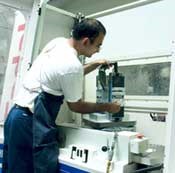HMC Provides Advantages Over VMC
U.S. aerospace prime contractors struggling to stay competitive are dictating cost reductions from suppliers.
Share




Hwacheon Machinery America, Inc.
Featured Content
View More


Autodesk, Inc.
Featured Content
View More
Additional productivity advantages come from the ability to set up more work per cycle and to perform the setup while the machine is cutting. With twin pallets, the machine can almost always be in cut. Setups and part handling can be done on the off-line pallet, while the other is in production. The result is much less downtime for setups and part handling, leading to substantially increased productivity.
The HMC’s 400-milimeter diameter pallets lock onto the simultaneous fourth axis rotary table with 13,000 pounds of holding force. A double enveloping gear on the rotary table and mechanical disk brake with 12 pads ensure accuracy of ±5 arcsecond and repeatability of ±1 arcsecond. The rotary table motor features a ratio of 180:1 and operates at 17 rpm. The machine also offers 20 inch by 24 inch by 20 inch XYZ travels.
The Siemens Sinumerik digital control is standard on the HMC 400. The features A and D finds useful are that the machine provides fully interpolated four-axis capability and program execution speeds for high speed machining. Rapid travel rates are up to 1,200 ipm (30.4 meters per minute) and can hold tolerances when contouring at feed rates up to 400 ipm.
Look-ahead, dynamic feed forward and programmable acceleration help provide comprehensive control for high speed machining of contours, hole position or any program with short axis moves. “The HMC 400 is very smooth when cutting,” Mr. Brown says. “The control moves the axis motors very fast with no jerking, so we get an excellent surface finish because of the acel and decel functions built into the control. Another feature is the ability to embed fixture offsets in the program.”
The company selected an optional 15,000-rpm spindle with air/oil lubrication that also proved to be a good pick. There was some concern that with the lower torque of the 15,000-rpm spindle, hogging operations would increase cycle time. “We’ve seen the HMC 400 rough aluminum at more than 100 cubic inches per minute,” Mr. Brown explains. “One part we make has a 13-minute cycle time, including roughing and finishing, on a VMC with a 10,000-rpm spindle. It’s down to 4 minutes on the HMC with a 15,000 rpm spindle.”
Another characteristic of the machine is that it maintains a constant temperature and ensures positioning accuracy with Fadal’s Cool Power refrigerated cooling system. By circulating a high performance heat transfer agent around the spindle nose and spindle cartridge and through the center of the gundrilled ballscrews, Cool Power reduces thermal growth and repeatability problems caused by heat. The heat transfer agent’s temperature is monitored and chilled as required to keep the temperature of positioning components within ±1.0 degree of the HMC’s ambient temperature. The system is a closed loop, isolating the heat transfer agent from chips and other contaminants.
A beta test without discovering some problems would be very unlikely. At least three problems were identified at A&D and have been corrected on subsequent machines.
“We experienced only a few hiccups during almost 2 months of beta testing,” Mr. Brown says. “We found a seal that was mispositioned and failed, and a switch on the pallet system failed. We weren’t down for very long, and the upside was we gained the opportunity to talk with the Fadal technicians, which gave us some additional insight and allowed us to learn more about maintaining and using the machine. The Fadal HMC 400 is very adaptable to anything we want to do. And it’s opening a lot of possibilities for us.”
Read Next
Building Out a Foundation for Student Machinists
Autodesk and Haas have teamed up to produce an introductory course for students that covers the basics of CAD, CAM and CNC while providing them with a portfolio part.
Read More5 Rules of Thumb for Buying CNC Machine Tools
Use these tips to carefully plan your machine tool purchases and to avoid regretting your decision later.
Read MoreSetting Up the Building Blocks for a Digital Factory
Woodward Inc. spent over a year developing an API to connect machines to its digital factory. Caron Engineering’s MiConnect has cut most of this process while also granting the shop greater access to machine information.
Read More










































.jpg;maxWidth=300;quality=90)



